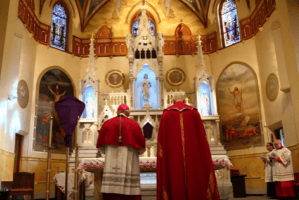
Scandals Drawn Attention Over Predator Priest. Other scandals had drawn national attention over the years: a pedophile priest in Louisiana, one in New England, another in Dallas. But none of those cases, or hundreds of others in the past two decades, threatened to destroy the moral authority of the Roman Catholic Church in America like […]

Scandals Drawn Attention Over Predator Priest. Other scandals had drawn national attention over the years: a pedophile priest in Louisiana, one in New England, another in Dallas.
But none of those cases, or hundreds of others in the past two decades, threatened to destroy the moral authority of the Roman Catholic Church in America like the clerical sex abuse crisis did this year.
What set 2002 apart was this: The most damaging revelations came not from alleged victims but from the church’s own files.
Over the objections of the Boston Archdiocese, The Boston Globe persuaded a judge in January to unseal church documents regarding claims of molestation lodged against priests. The files provided the most extensive evidence to date that preventing scandal in the church consistently took precedence over protecting children.
Those records alone with letters from bishops expressing support for accused priests, not victims would have been enough to keep the scandal alive for months.
But as the year wore on, more damaging church documents were made public in Boston and dioceses across the United States. Each release undermined bishops’ pledges that they had revealed all about their past mistakes and gave hundreds of alleged victims the confidence to come forward.
A flurry of disturbing revelations in December, again in Boston, brought the resignation of Cardinal Bernard Law, who begged forgiveness from “all those who have suffered from my shortcomings and mistakes.”
The documents showed the archdiocese sheltering several rogue priests, including one clergyman who had failed years ago to call police immediately when the mother of his children overdosed on drugs.
“It’s enough for any Catholic, for anyone at all, to send chills down your spine,” said William Donohue, president of the Catholic League, an anti-defamation group. “Where is the empathy for the victim?”
The overall toll on the church — morally, financially, legally is still hard for Catholics to grasp, though at least 325 of the nation’s 46,000 priests have resigned or been removed from their posts this year from Maine to California. Besides Law, bishops in Milwaukee; New York; Lexington, Kentucky, and Palm Beach, Florida, stepped down after being enmeshed in sex scandals.
Documents released in the case of former Massachusetts priest John Geoghan started what became the worst year in the history of the American church.
More than 100 people have claimed Geoghan molested them as church leaders moved him from parish to parish.
Five bishops who oversaw the priest while they worked in Boston for Law have gone on to lead their own dioceses, and the court files contained ample evidence of their inaction. Law, a leading American clergyman, acknowledged that he allowed Geoghan to stay on the job despite the accusations.
Soon, Catholics around the country demanded to know if their bishops had also failed to punish offenders.
“Until this year, I don’t think that most Catholics had any idea how morally compromised most of these bishops were,” said Jason Berry, author of “Lead Us Not Into Temptation: Catholic Priests and the Sexual Abuse of Children.”
Bishops at first felt the outrage was misplaced. In the early 1990s, the U.S. Conference of Catholic Bishops developed a set of guidelines meant to improve dioceses’ response to abuse claims and put victims first.
The prelates noted that most of the cases revealed this year involved claims from before the policy had been adopted. They blamed the media and church critics for ignoring the reforms.
But the bishops’ protests rang hollow as parishioners learned about the depth of the malfeasance in some dioceses.
Bishops acknowledged that many abuse claims had never been forwarded to civil authorities, and prosecutors convened grand juries to learn why. Church leaders also revealed they had paid millions of dollars to settle abuse cases quietly, but few would discuss the source of the funding. Some parishioners responded by withholding donations.
“There are cases that endured into the ’90s that weren’t corrected in Boston and elsewhere,” said Scott Appleby, a University of Notre Dame history professor who spoke at the national bishops’ meeting in June. “The bishops have systematically mishandled the situation.”
Church leaders took dramatic steps to regain their credibility.
They met with the pope, approved a new policy that bars all abusers from church work, formed a lay National Review Board to ensure every diocese complies with the new standards and hired a former FBI investigator to lead their new child protection office.
But even as they took these actions, the crisis would not die. The Archdiocese of Boston is now considering bankruptcy as it faces millions of dollars in claims from sex abuse victims. About 200 abuse lawsuits are pending against the Archdiocese of Louisville, Kentucky, alone.
And California dioceses are bracing for a flood of lawsuits next year because the state loosened its statute of limitations for abuse claims effectively Jan. 1.
“No problem that has been happening for so long, kept in such secrecy, can be quickly remedied,” said David Clohessy, national director of the Survivors Network of Those Abused by Priests.
“We desperately want it to be over, but it’s only over when the day-to-day behavior changes. We can’t wish it to be over.”
The personal injury attorneys at Parker Waichman LLP offer free, no-obligation case evaluations. For more information, fill out our online contact form or call 1-800-YOURLAWYER (1-800-968-7529).


